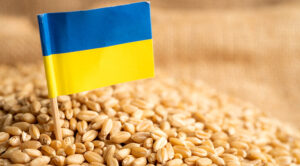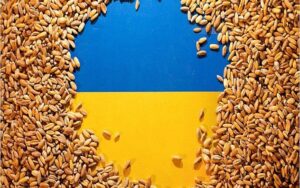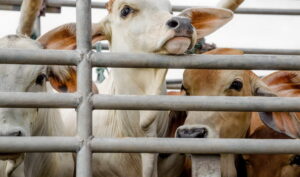
The U.S. Department of Agriculture (USDA) has lowered its forecast for Ukraine’s grain production by 13% and exports by 26% due to the country’s depleted stocks.
According to the February forecast, the country’s ending grain stocks in the 2024-2025 marketing year (MY, July-June) are estimated at 1.8 million tons, up 19% from last year, but significantly lower than before the large-scale invasion in February 2022.
The EU will remain an important destination for Ukraine given its liberalized trade policy and geographical proximity. At the same time, Ukrainian exporters continue to regain their traditional markets, made possible by the efficient operation of the Black Sea ports, the report says.
According to the USDA, the wheat harvest in 2024/25 MY in Ukraine will amount to 22.9 mln tons, which is the same as last year, but its exports will decrease by 19% to 15 mln tons. The barley harvest will be 3% lower than in the season-2023/24, and is estimated at 5.9 million tons, while exports will amount to 2.6 million tons. The forecast for rye production was lowered by 18% to 190 thousand tons.
Rye has become a niche crop for Ukrainian farmers, so its production and exports can vary significantly from year to year, the USDA said.
The USDA forecasts the largest reduction in corn, the production of which will decrease by 24% compared to 2023/24 MY – to 24.6 mln tons, while exports will fall by 33% – to 19.6 mln tons. The ending stocks of the grain are forecasted at 722 thsd tonnes, up slightly from the previous year, but significantly lower than the 2.8 mln tonnes that were in reserve at the end of the 2022/23 season.

Ukraine’s imports of goods in January 2025 increased by 7.8% y-o-y, from $5.1 billion to $5.5 billion, while exports decreased by 5.9%, from $3.4 billion to $3.2 billion, the State Customs Service reported on Monday.
According to information on its website, January imports are the highest since 2023, when they reached $4.8 billion, while exports returned to the level of 2023, when they amounted to $3.1 billion.
“Taxed imports (in January-2025 – IF-U) amounted to $4.1 billion, which is 74% of the total volume of imported goods. The tax burden per 1 kg of taxable imports in January 2025 amounted to $0.49/kg,” the State Customs Service said in a statement.
It is noted that China imported the most goods to Ukraine – by $1.4 billion, Poland – by $487 million and Turkey – by $389 million.
Ukraine exported most of its goods to Poland – by $352 million, Italy – by $205 million, and Spain – by $202 million.
In the total volume of goods imported in January 2025, 68% were in the categories of machinery, equipment and transport – $2.2 billion (UAH 12.9 billion, or 27% of customs revenues, was paid to the budget), chemical products – $901 million (UAH 7.3 billion, 15%), and fuel and energy – $734 million (UAH 14.2 billion, 30%).
The top three most exported goods from Ukraine were food products ($1.8 billion), metals and metal products ($325 million), and machinery, equipment, and transport ($282 million).
In January 2025, a total of UAH 22.2 million was paid to the budget during customs clearance of exports of goods subject to export duties.

In January 2025, Ukraine exported 8.1 thousand tons of dairy products, which is 12% more than in December 2024, and 23% more than in January 2024, the Association of Milk Producers (AMP) reported, citing data from the State Statistics Service.
The industry association noted that the main export categories were milk and cream, condensed – 29%, milk and cream, not condensed – 21%, whey – 18% and cheeses – 12%.
In January 2025, compared to December 2024, Ukraine increased natural exports of butter to 749 tons (+71%), ice cream to 490 tons (+37%), condensed milk and cream to 2.33 thousand tons (+16%), whey to 1.44 thousand tons (+12%), butter to 422 tons (+10%) and cheese to 935 tons (+9%). However, over the past month, Ukrainian exporters have reduced shipments of milk and cream, not condensed to 1.72 thousand tons (-9%) and did not supply casein to foreign markets.
The AMP noted that January exports in 2025 increased compared to January 2024 for the following products: butter (+198%), ice cream (+77%), whey (+55%), cheeses (+52%), butter (+42%), and condensed milk and cream (+38%). Ukrainian exporters shipped milk and cream, not condensed, by 32% less than last year.
AVM analyst Giorgi Kukhaleshvili suggested that Ukrainian companies stepped up export activity in January 2025, taking advantage of high prices for commodities in the world. In particular, the European market was in demand for large wholesale quantities of butter. Consequently, demand for butter, cheese, and milk powder increased in January on export markets, likely due to preparations for the Chinese New Year and Ramadan.
At the same time, in January 2025, Ukraine imported 5.02 thousand tons of dairy products, which is 34% less than in December and 6% less than in January 2024. Compared to December 2024, Ukraine increased imports of whey to 628 tons (+17%), butter to 615 tons (+165%) and ice cream to 51 tons (+53%), the AMP summarized.

Since the beginning of 2024-2025 marketing year (July-June) and as of February 7, Ukraine exported 26.449 mln tonnes of grains and pulses, 758 thsd tonnes of which were shipped this month, the press service of the Ministry of Agrarian Policy and Food reported, citing the data of the State Customs Service.
According to the report, as of the same date last year, the total shipments amounted to 24.716 mln tonnes, including 840 thsd tonnes in February.
In terms of crops, since the beginning of the current season, Ukraine has exported 11.073 mln tonnes of wheat (269 thsd tonnes in February), 2.079 mln tonnes of barley (15 thsd tonnes), 10.8 thsd tonnes of rye (0), and 12.865 mln tonnes of corn (472 thsd tonnes).
The total export of Ukrainian flour since the beginning of the season as of February 7 is estimated at 44.3 thsd tonnes (0.7 thsd tonnes in February), including 40.9 thsd tonnes of wheat (0.7 thsd tonnes).

Prices for live cattle have risen sharply in Ukraine – by almost 20% over the past week, as of February 5, they increased from 64 to 74 UAH/kg and demand remains high, according to the Association of Milk Producers (AMP).
“The main driver is the increased demand from exporters. There are a number of factors, including the early Ramadan 2025 and the limited presence of live cattle from the EU due to outbreaks of foot-and-mouth disease,” analysts said.
Experts explained that usually the demand for live cattle fades in November and after the New Year’s lull is restored in March under the influence of growing export demand to Arab countries. However, this year Ramadan begins on February 28, so the demand for slaughter cattle from Lebanon and Jordan has increased since the first days of January.
The industry association predicts that amid a shortage of bulls of marketable condition, a rapid decline in raw milk prices and a lack of working capital for the sowing season, including due to delays in payment for raw materials, dairy farms may begin to actively reduce their livestock.

In the first five months of the 2024-2025 marketing year (September 2024-January 2025), Ukraine exported more than 352 thousand tons of sugar to foreign markets, which is 17% more than in the same period of 2023-2024 MY, the press service of the National Association of Sugar Producers of Ukraine Ukrtsukor reported on Facebook.
The business association emphasized that the entire exported volume was directed to the world market, while in September 2023-January 2024, the share of exports to the world market was only 9.5%.
“The significant increase in the world market share in sugar exports is the result of successful efforts of Ukrainian sugar producers to find alternative markets due to restrictions imposed on Ukrainian sugar by the EU,” the industry association explained.
The main export destinations for Ukrainian sugar in September 2024-January 2025 were Turkey (19% of total exports), Libya, Somalia, Sri Lanka, and North Macedonia.
Ukrtsukr noted that since January 1, 2025, the possibility of exporting sugar from Ukraine to the EU countries has been restored. During the first 5 months of 2025, the domestic producers will be able to export 107.3 thousand tons of sugar to the EU.
As reported, in the production season of 2024, Ukrainian sugar producers produced 1.8 million tons of sugar. The volume of the domestic market in Ukraine is currently estimated at 900 thousand tons per year.